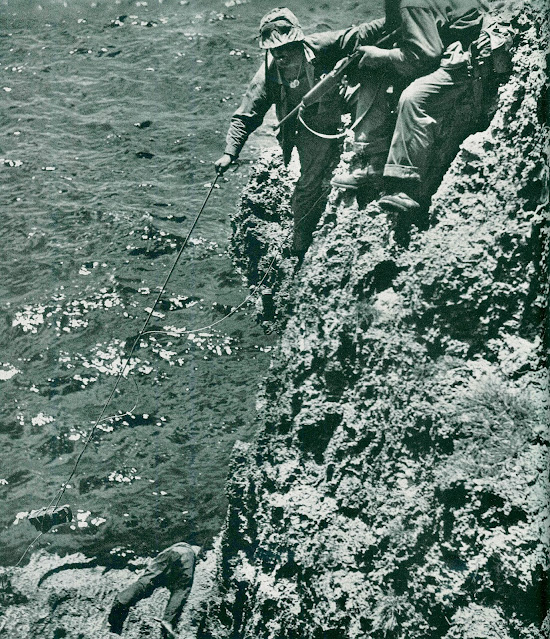In the Pacific War, American troops lowered explosives from the top of a seaside cliff and swung them into the opening of a cave in a sheer rock wall to sweep away Japanese soldiers in a cave on Saipan. They also blew up and killed any Japanese soldiers and civilians who might be hiding in the cave on that cliff. On top of the cliff by the sea were the bodies of the Japanese snipers who had been killed in the explosion. Only a few minutes before, he had been sniping at American soldiers and civilians on the beach, but the American sniper had shot and killed the Japanese soldier himself. Most tragic of all was the suicide by jumping off the cliffs at the northern end of the island. A Japanese man had jumped off the cliff on the north face of Cape Mappi. American soldiers used loudspeakers to persuade the Japanese that they would not be harmed, but obviously to no avail.
In the Battle of Saipan, many Japanese soldiers and civilians were unable to surrender or survive. In order to surrender, they had to flee under fire and shellfire. The Japanese forbade anyone to surrender to death. Anyone who surrendered to the Americans risked being killed by the Japanese soldiers. The last surviving Japanese soldier in the cave held a large Japanese sword and threatened to slit the throat of any Japanese who surrendered to the Americans. The Japanese soldier also chose to commit suicide rather than be executed by his own side for trying to surrender to the Americans.
Shortly after sunset on July 6, the remaining Japanese soldiers began to assemble for a Hail Mary attack that would destroy them all. At 4:55 a.m. on July 7, the first Japanese officer arrived, brandishing a sword above his head and shouting Hail, followed by thousands of Japanese soldiers charging in. The largest Hail Mary attack of the Pacific War lasted about 12 hours before it was annihilated, killing a total of about 4,311 Japanese soldiers. About 406 American troops were killed in action, and about 512 were wounded. U.S. forces occupied Saipan and declared it safe on July 9, 1944, more than three weeks after the start of the invasion.
At 4:55 a.m. on July 7, the first Japanese officers arrived, brandishing swords overhead and shouting Hail Mary, followed by a charge by thousands of Japanese soldiers. The Hail Mary attack lasted for about 12 hours before it was annihilated, and a total of about 4,311 Japanese soldiers were killed. About 406 American troops were killed in action, and about 512 were wounded.
Saipan has been occupied and colonized by Japanese forces since World War I. When about 127,000 U.S. troops invaded from June 15, 1944, there were about 26,000 Japanese troops, 6,000 naval personnel and 30,000 civilians on Saipan. About 24,000 Japanese soldiers were killed in action and about 5,000 committed suicide. About 912 Japanese POWs survived. About 22,000 civilian Japanese were killed. About 3,426 American troops were killed and about 10,364 were wounded.
In every age, it is the citizens who are made the perpetrators and victims of war. INWN wants the generation of peaceful citizens who have never known war to remember the "Truth of Wars". Keep in mind that blogs that record the facts of war and peace should be viewed not only for their interest and significance. Only "The Truth of Wars" can be a true deterrent to war by peaceful citizens. Let's explore international peaces as the Citizens for Global Peace from International No War NGO.
5/30/2021
Cleaning out a cave on a Saipan, US Marines perched on a seaside cliff lower a charge of explosives and swing it into the cave opening in the sheer rock wall to blow up any enemy troops who may be still holed up inside.
Fifteen Vietnamese civilians were killed and four injured by the explosion of a mine on a country road 8 km west of Tuy Hòa, March 18, 1966.A mother became a victim of a landmine explosion and her daughter cried out beside the corpse.
About 15 Vietnamese civilians were killed and four others wounded in a landmine explosion on a rural road about 8 km west of Tuy Hoa in Sout...

